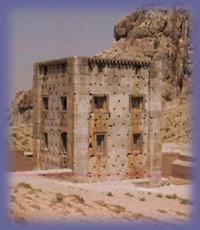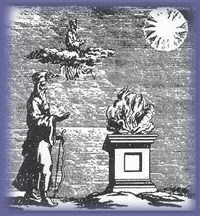
Ancient fire temple
(near Persepolis)
Ahura Mazda, knowest to be the best in life;
Whoever does right for the sake of right;
Whoever in authority governs with the aid of the Good Mind...
I shall cross with them the Bridge of Separation.
Yasna 46.10
In several mythologies, bridges lead from the realm of mortals to the land of the dead, or to the abode of the gods. Here Zarathustra is speaking of the Cinvat (‘separation’) bridge leading the dead from the land of the living— over the gaping abyss of hell—into paradise. When the righteous cross, the bridge is wide, whereas it becomes narrow as a razor when the ‘wicked’ seek to cross, precipitating them off the bridge into a most perilous fall. (The bridge al-Sirat, ‘the path’, of Islamic cosmology is almost certainly derived from this tradition.)
Many of us who have never heard of Zarathustra are nonetheless familiar with this particular mythic image. The idea that a dangerous transition becomes safe only for those on the ‘right’ path was illustrated beautifully in the Fellowship of the Rings, when the heros are forced to escape the mines of Moria over the bridge of Khazad-dum (although Gandar does not survive the passage, he nonetheless survives the fall).
There is a paradox here, in that the good way is often conceived of as ‘narrow’. Yet if we consider that ‘good thoughts, good words, good deeds’ might refer to that which is creative for the individual, it is clear that to follow such a path does indeed lead to a broader experience of spirit. And that to disregard that which might be good for us—which doesn’t mean the ‘safe’ way, or that it will be good for everyone around us—narrows our prospects, and even might precipitate a fall.

Zarathustra and
the sacred fire
Give
me this sign: the total transformation of this existence...
Yasna 34.6
Many
scenarios of the renovation of the world were known in the ancient world,
and were ritually invoked in New Year celebrations. However Zarathustra
believed in an ultimate transfiguration which could be effected once and
for all—which perhaps occurs for all of us in those once-in-a-lifetime
moments when we experience a moment of meaning, when our day-to-day lives
appear radiant with light.
After his death, many legends arose about Zarathustra: for instance that
nature had rejoiced at his birth, that he had preached to many nations,
founded sacred fires, and fought in a sacred war. The Greeks regarded
him as a philosopher, mathematician, astrologer, or magician, the word
magic deriving from the Magi, who appear to have been a hereditary
caste of priests who adopted a number of Zoroastrian rites and customs.
Once a religion with many followers, there are currently only about 200,000 Zoroastrians, most of whom can be found in Iran—centred round the town of Yazd—and India (mostly in the Bombay area, where they are known as Parsees, i.e. ‘Persians’). Zartusht-no-diso is the day in the Zoroastrian sacred calendar when worshippers remember the death anniversary of Zarathustra; special prayers are recited and a visit is paid to the Fire Temple as a mark of remembrance.